In a troubled world not unlike our own, two lizard-men tumble from the sky to an abandoned jetty by the sea. Inhabited only by a sad sack cyclops, a satanic bird, and a sexy snail, the jetty becomes a raunchy boys’ room, an Edenic dope yard of pleasure and sick until one day…Daddy’s home.
—Asher Hartman, Sorry, Atlantis: Eden’s Achin’ Organ Seeks Revenge
Three stalwart clubhouses of the Los Angeles performance community, Pieter Performance Space, PAM Residencies, and Machine Project, underwent major renovations in 2016 and 2017. These projects are housed in buildings originally constructed for work, congregation, and commerce in the 1920s, a period of architecture and population booms in Los Angeles, during the birth of Hollywood. Today, all three spaces are venues for some of the most progressive art being produced in Los Angeles. Their buildings’ pasts as former sites of collective labor and gathering provide the scaffolding for work that insists on collaboration. Yet, Pieter, PAM, and Machine not only speak to their pasts but also impact their present through their distinct malleability, casting space in a feature role for contemporary performers concerned with participatory theater, studio as site, and site specificity.
Pieter Performance Space was founded in 2010 as an equitable place for experimental dancers to nurture, explore, and share new work. Pieter has a generous spirit—entrance to all programs is by suggested donation, and there is a “give one, take one” closet full of clothes and books in the back. Founder and now custodian Jmy James Kidd describes Pieter as an “etheric body,”1 the subtle breathing-being that twins humans’ physical existence. To Kidd, Pieter is very much alive. Likewise, Pieter’s director, Dorothy Dubrule, thinks of Pieter as “a cat that has many homes with lots and lots of different people. Each of them are intimate and unique, and many of them are long-term relationships, but most often they are unaware of one another. [But it’s a] messy metaphor, because Pieter is both the cat and the home.”2
Kidd found Pieter’s converted industrial space on Craigslist eight years ago. It was formerly an electric company (maybe), built in (possibly) 1923, on a corner lot in Lincoln Heights surrounded by concrete, train tracks, and warehouses. The front door opens to a set of steep stairs. At the top of the steps is an 1800-square-foot open-air room that looks similar to a standard ballet studio (well lit, wood floor, cleared space). Instead of barres, this room has four pillars squarely in the center, jutting from floor to ceiling. These notorious columns have become players in all performances in the space. As the architects and writers Kent C. Bloomer and Charles Willard Moore state in Body, Memory, and Architecture, “Columns were surely celebrations of the special human upright stance even before they were pressed into service to hold up roofs over human bodies…Four columns together holding up a roof formed a ceremonial canopy with evident creative or regenerative powers.”3 Pieter’s columns are more than the obstacles we might first perceive them to be—they both evoke a figurative presence and invite interaction with bodies in surprising and significant ways.

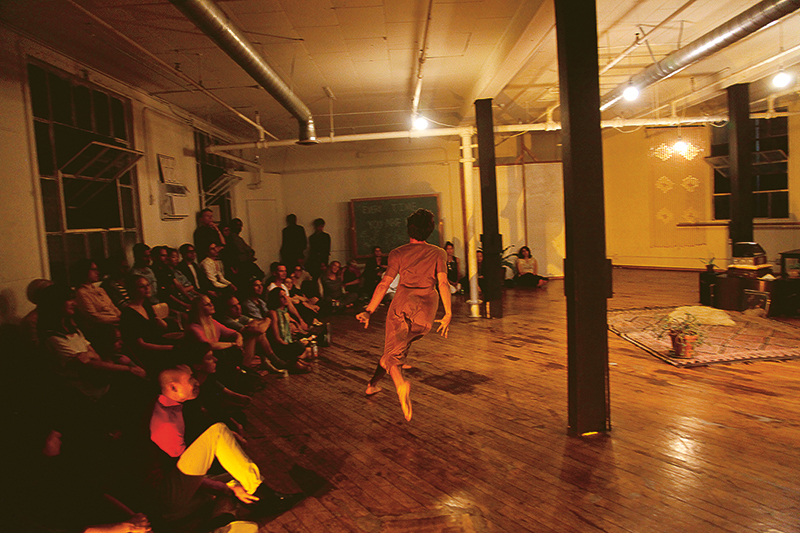
Nick Duran, every time you are near, 2014. Performance at Pieter Performance Space, Los Angeles, April 14, 2014. Courtesy of the artist and Pieter Performance Space. Photo: Amanda Björn.
Not so long ago, I attended a marathon dance performance at Pieter in which four women moved around one another in configurations that simulated the shifting shapes within a kaleidoscope. I slid too abruptly against the grain of the wood floor and got a splinter in my butt. All night, while I wrestled with backward bending acrobatics to remove the sliver of wood from my flesh, I thought, ah so, we carry spaces with us. When the existing floor, although beloved, consistently left the dancers with blood drawn from the splitting wood (and once, a foot went almost clear through the ceiling below), Pieter raised money for new, more practical flooring. When the goal was met, there was a ceremony of music and dance to say goodbye to the old and bless the new. The crowd gathered on blankets and pillows and drank donated tea, as two dancers mimicked one another from in and around the central columns. Pieter closed for months for the rehabilitation. Besides the floor, Pieter was updated with track lighting and a fresh paint job—the off-white walls turned a fleshy warm beige and reddish brown. Like all breathing bodies, Pieter is aging into more accurate versions of herself: a space that provides a steady ground, both physically and emotionally, for people to move upon. Although part of me misses the old floor, the work that is produced here now, after the renovation, can go in directions unfeasible before, as more dynamic moves can be made upon a surface that doesn’t splinter. My excitement for possible futures far outweighs my nostalgia. Building up and taking down can lead to the same end—that sense of carrying spaces with us.
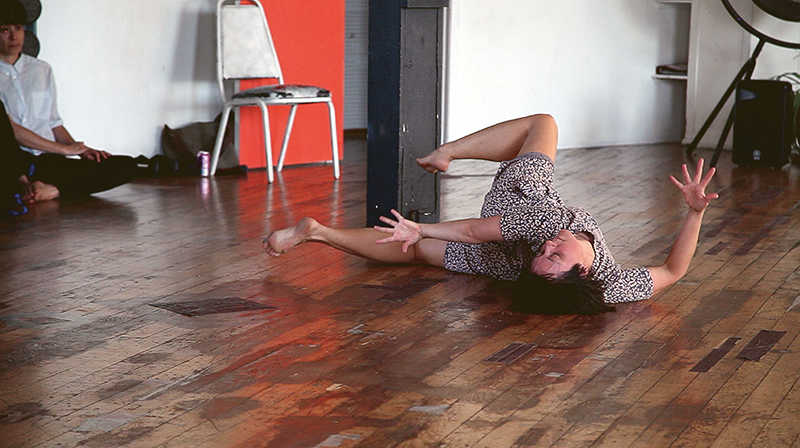
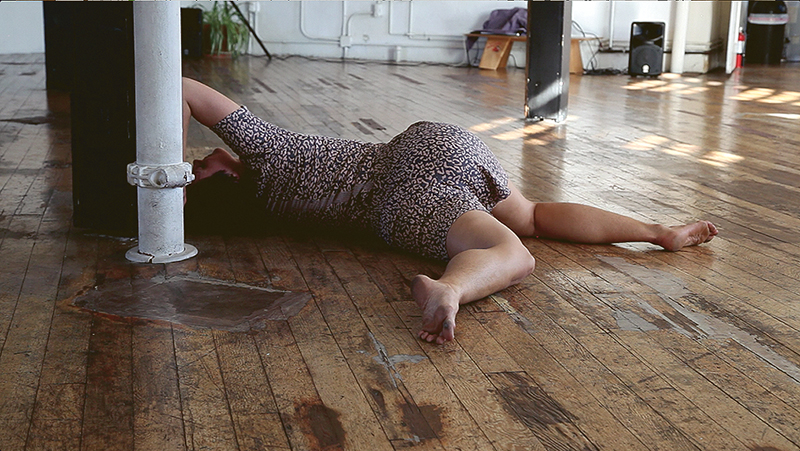
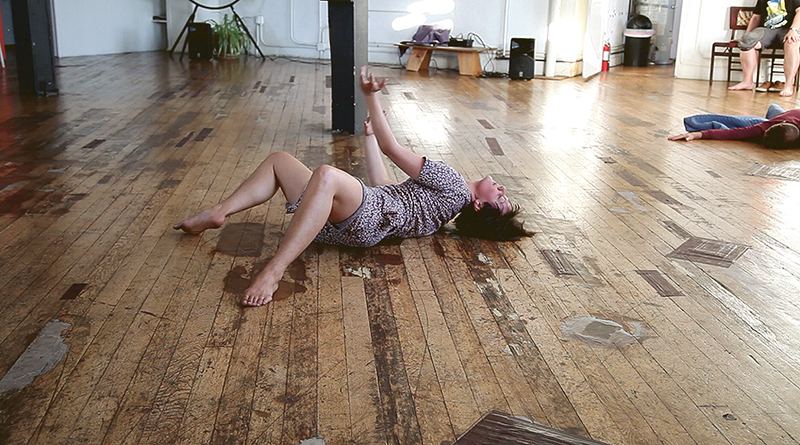
Jmy James Kidd, Jmy’s Gonna Dance, May 20, 2017. Improvised dance, 170 mins. Kidd performed this dance a few times during the month before the renovation, as a way of saying good-bye to the floor and to a certain type of studio and performance practice. Courtesy of the artist. Video stills: Joanne Kim.
Pieter has a metaphorical sister, opened in 2013, a few miles to the northeast, proper name: PAM Residencies. Through physical space, time, and a public stage, PAM engenders new and innovative performances. Located in a former Evangelical church, PAM, is a second-story studio in a brick building overlooking Figueroa Street in Highland Park, wedged between a RadioShack (the out) and a holistic acupuncturist (the in). A flimsy door leads to stairs covered in detritus from the night before—a stray orange, plastic crowns of leaves, neck ruffs—which lead to a branching center hall. One way takes you to a private studio and the other toward PAM’s signature performance room, a long, low, and narrow space. The old churchgoers had demarcated the space into thirds, but founder and director Brian Getnick tore the dividing walls down to allow artists to expand their performances as far as the 13 x 33 x 8 feet will allow.
There are windows on every wall, even looking into the stairwell. At 7:00 pm each night a street lamp turns on outside the large picture window. Both the lamp and window have played roles in many performances here. For a work of my own, I once sat on the sill and quoted melodramatic texts to the street. “It’s a lighthouse,” says Getnick.4 He is quick to assert that PAM too has consciousness, referring to the space as “she” and encouraging artists to use “her” in their work. He says, “PAM is not a character but is a co-actant, as the space is designed a certain way and changes year by year, a sculpture that evolves through the force of different performers working inside it.”5 To Getnick and many of her occupants, PAM is not only an influence but also an active contributor to the work produced inside her walls. She has been a proscenium stage, comedy club, concert hall, and classroom, variably fostering stand-up routines, movement exploration, and experimental dance and theater, while also acting as a receptacle for the uncategorizable.
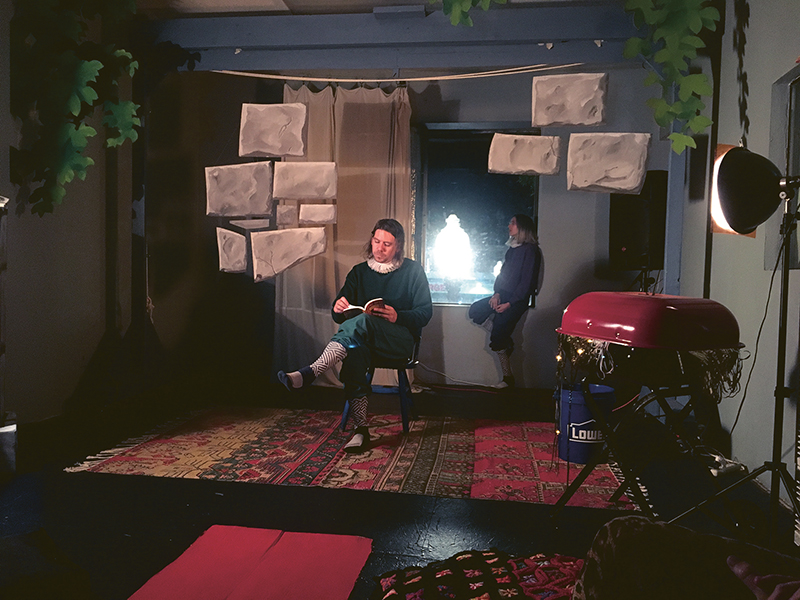
Tim Reid and Meg Whiteford, Slow Jams and Afghan Hounds, 2016. Performance at PAM Residencies, Los Angeles, November 18–19, 2016. Courtesy of the artists. Photo: Leah Clancy.
The sentience of PAM as a performance space is achieved through constant removal, replacement, and reconfiguration of the elements of the space. PAM’s walls, old slim floorboards, and the Shaker-influenced benches were once painted in a brilliant blue that I thought was an homage to Yves Klein, but I was promptly corrected by Getnick. (“Ahem, it’s ‘Prelude Blue.’”)6 This trademark color itself provided a distinctive frame and influenced the tone of many performances. Last year, PAM replaced those sticky, blue, down-at-the-heel floorboards with new wide unpainted pine boards that, according to Getnick, “came from seeing all that painted worn pine flooring in apartment complexes in Berlin, wondering about the history embedded in that soft wood; and here again is the Shaker reference, thinking about a New England barn. I think the scale of the boards harkens towards an enormous space cropped within the small blue studio. Big time in a little space.”7 Just as PAM accommodates her performers, now that her floorboards have a new color, it will be interesting to see how the performances will change to meet the new, barn-like PAM.
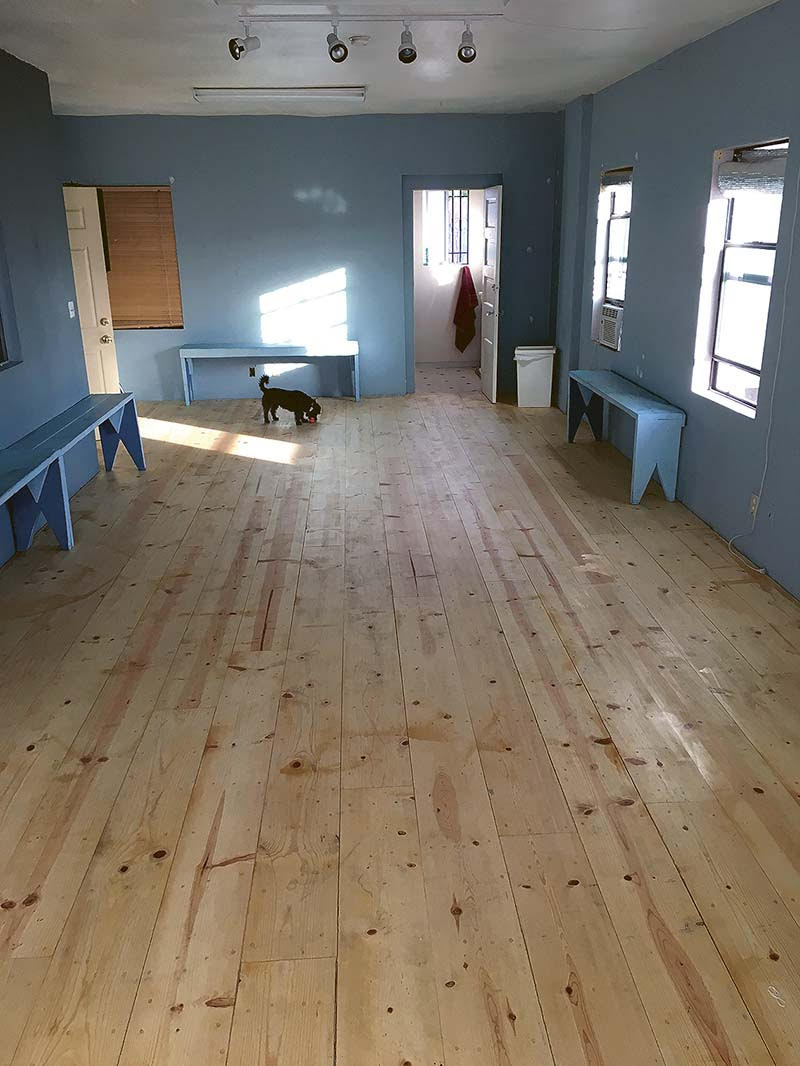
PAM Residencies after the renovation, 2017. Courtesy of PAM Residencies. Photo: Brian Getnick.
Machine Project was a curatorial project dreamed up by Mark Allen, established in 2004, and run out of a storefront in Echo Park. Machine’s ethos foregrounded collaboration, performance, and the sharing and disseminating of knowledge. Over the course of their almost fourteen year run, they produced over 1500 events and worked with over 800 artists. The organization announced the end of the venture in early 2018. The building was, at one time, a grocery store with a small hotel above. Picture windows provided street-level visibility to Machine, in contrast to the ascending reveal of PAM and Pieter. Machine’s windows were pasted-over with a chronicle of posters, flyers, and remnants of erstwhile events, obscuring the view of inside with reams of that which once was. In this way, it gave its past a visible record, as Pieter and PAM do by posting ephemera in ancillary spaces, such as stairwells and bathrooms. Machine’s front room had yet another ramshackle wooden floor, which was punctuated with several trap doors and pockmarked by holes from events past.8 Behind a panel at the back of that room, a set of stairs led down to a Victorian theater with seventeen plush pink-red seats, baroque embellishments and quatrefoils, dim sconces, and a proscenium stage. The classical drama that these elements recalled inevitably penetrated whatever experiment performed in this basement, twisting the contemporary around the little finger of a [faux] historical context.
Machine worked with artists to change the shape of the space many times over, “manipulating the space in ways unusual for a renter.”9 In addition to the basement theater, projects included “removing the floor and reinstalling it at a 30-degree angle, cutting a trap door through the entire building, and burying people alive (for 15 minutes) in a backyard grave dug by [the organization’s] first intern.”10 Allen describes Machine’s perpetual updating as less a restructuring than a “constant state of becoming.”11 This becoming is another way of relearning and experiencing oneself through new configurations. Buildings—thanks to wear and tear, new ownership, gentrification, style trends, etc.—inevitably must oblige multiple future selves. The different incarnations of PAM, Pieter, and Machine endure through the living archives of the buildings themselves alongside archives of photos and text, much the way we construct the narratives of our own evolutions.12
Can we expect anything to remain the same when we burdened beings use it? The artist Gordon Matta-Clark says that destruction and intervention in buildings is “intimately linked with the process as a form of theater in which both the working activity and the structural changes to and within the building are the performance…I see the work as a special stage in perpetual metamorphosis, a model for people’s constant action on space as much as in the space that surrounds them.”13 The updating that occurs in these three creative spaces is part of their entire vision, the theater of being Pieter, PAM, and Machine.
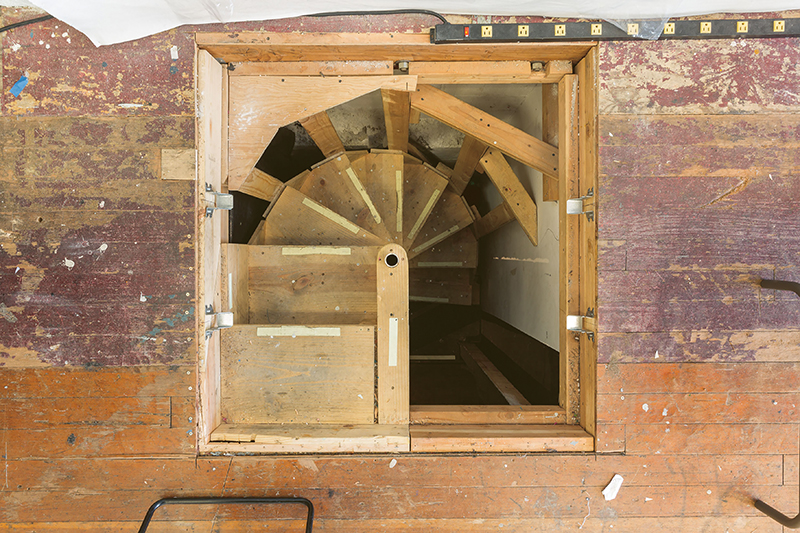
The trapdoor and spiral staircase down to the Mystery Theater at Machine Project, Los Angeles, 2016. Courtesy of Machine Project. Photo: Ian Byers-Gamber.
After Machine’s closure, the building remains, awaiting its new identity. Meanwhile, its project has become a memory shared by its participants, visitors, and staff. As described by Allen, it is a cache of “all the absurd things we did and got away with, all the people who met there and got married and had kids, all the performances…all the uncertain and uncomfortable feelings. And according to intuitive/psychic/playwright Asher Hartman, ‘many memories and ghosts from long before we were there.’”14 Machine’s last role was presenting a one-month run of one of its arguably more theatrical theater pieces—an Asher Hartman spectacle featuring lizard men, cyclops, and satanic birds, entitled Sorry, Atlantis: Eden’s Achin’ Organ Seeks Revenge. 15 Hartman turned Machine’s trapdoors into portals, the upstairs into a site of hierarchal judgement in conversation with the lowly basement, and tilted the entire floor at an angle to mirror the unruly layout of human memory and the unconscious. Unlike Pieter and PAM, who renovated to facilitate continued production, Machine refitted itself one last time before tearing the house down, and, perhaps, evading nostalgic commemoration for its brief but vigorous life by initiating its own self-destruction.
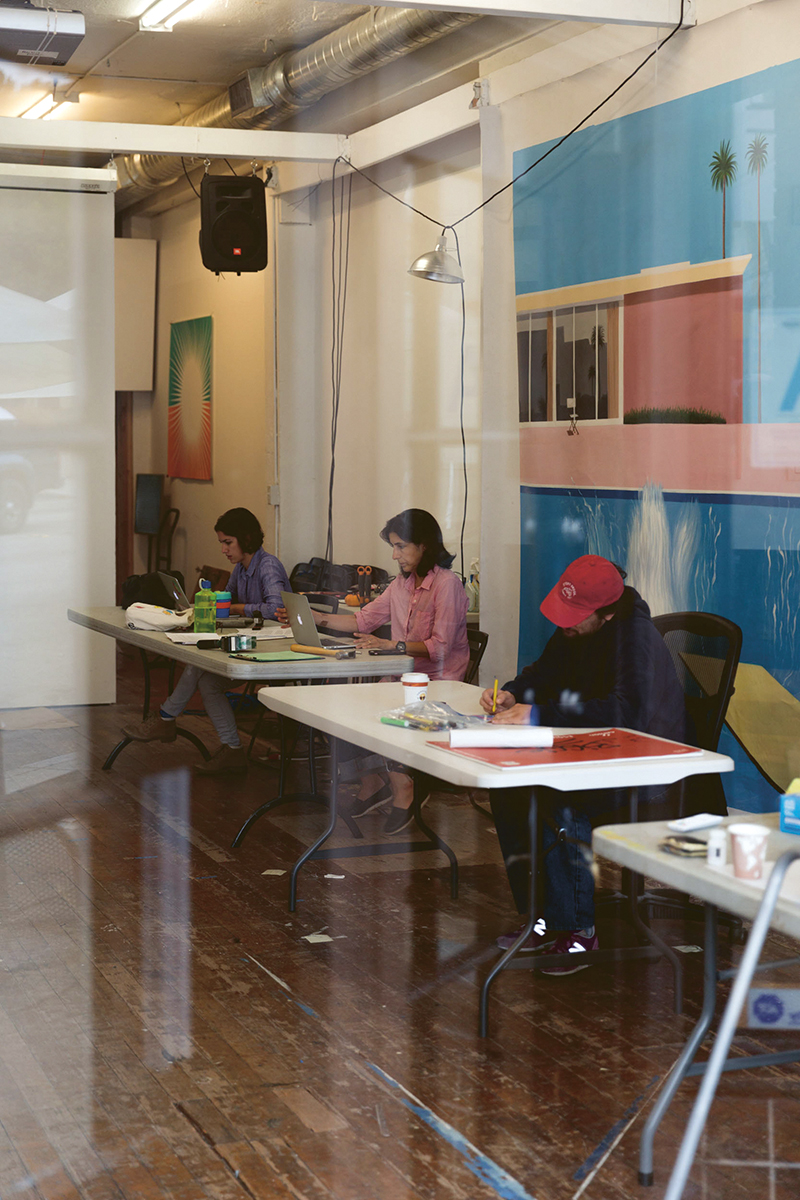
The storefront at Machine Project, Los Angeles, 2016. Courtesy of Machine Project. Photo: Ian Byers-Gamber.
In radical contrast to these three scrappy, fluctuant art spaces, and in the same Los Angeles cultural moment as their renovations, the Los Angeles County Museum of Art revealed its $600 million plan for a new wing and renovation. The design was devised by LACMA Director Michael Govan and Swiss architect Peter Zumthor. Zumthor’s original model depicted an oozy black configuration that would protrude across Wilshire Boulevard like some villainous excrement. The gesture, which Zumthor calls his “black flower,” was meant to mimic the nearby La Brea Tar Pits. Ultimately, he claimed his vision was “too fragile to survive the trip.” Instead, he settled on a more practical structure—a pre-Columbian block house design made of unpainted concrete, the black creature now turned to sand to match the hue of the desert landscape. The color of the interior will match the exterior, creating a “monolithic architectural experience,” according to the architect, taking the pursuit of neutrality in service of its display-case function for art to an extreme desire for a-historical timelessness. “It took me a while to sort of let go of the baby,” he added, referring to the original design. “But I think I’ve figured it out. I’m happy. It’s less slick and more substantial. Elemental. If I’m lucky the building will be like some kind of an Inca [sic] temple that’s always been in the sand and now they’ve excavated it—a really old piece that’s always been there.”16 The renovation will be a bridge across a major throughway, an expansive tunnel filled with pockets of galleries, and a perverse update for the future via a nostalgic fantasy of the past. Zumthor should take note that even the Parthenon is protean; it became a mosque, which then became a storehouse for gunpowder, and then a target for a cannonball.
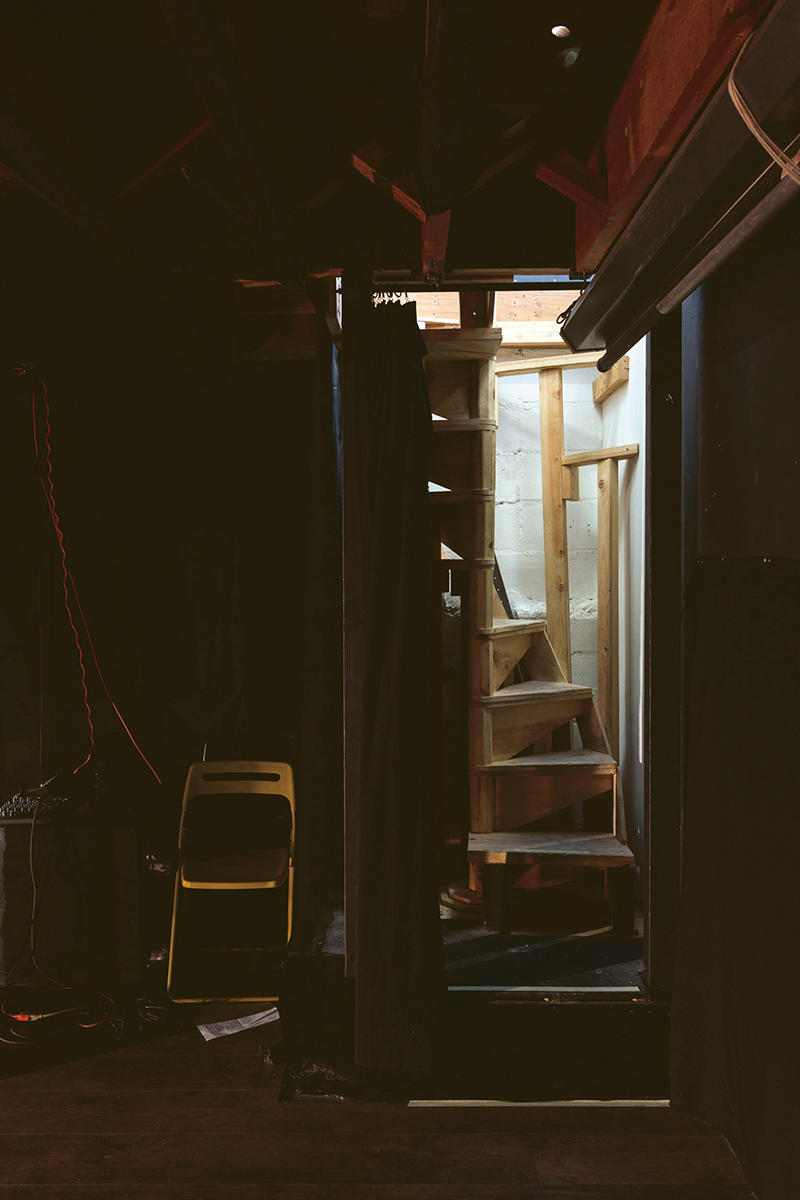
The trapdoor and spiral staircase down to the Mystery Theater at Machine Project, Los Angeles, 2016. Courtesy of Machine Project. Photo: Ian Byers-Gamber.
Zumthor’s colonial fantasy fits into and capitalizes on the typecast aesthetic of ornate and exoticized architectural icons of 1920s Los Angeles that resemble Hollywood film sets (Chinatown’s arches, The Mayan, Grauman’s Chinese Theatre, The Egyptian).17
These movie premiere ready facades contrast with the more prosaic architecture of Pieter, PAM, and Machine Project, which originally were constructed to accommodate an influx of immigrants and industrialized labor. Needless the say, the Incans never made it further north than Columbia, and the oldest known inhabitants who did reside in pre-Columbia Southern California for millennia, the Chumash, made their ‘apa‘yik structures from willow or whale bone covered in grass—materials with a brief and seasonal lifespan. These made for structurally sound buildings capable of repelling rain and holding a fire.
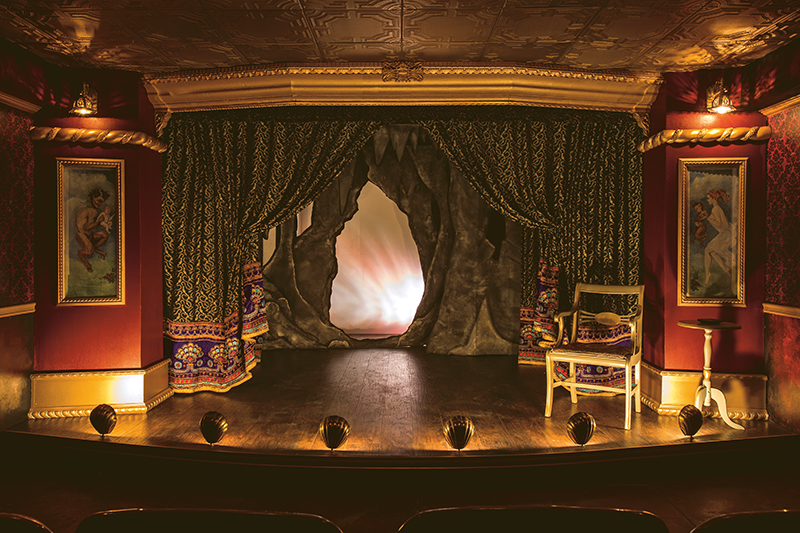
The Mystery Theater at Machine Project, Los Angeles, 2013. Courtesy of Machine Project. Photo: Laure Joliet.
Still, if a cultural space is an etheric body, a collaborator, or in a state of becoming, it lives and must be tended to. As Frank Lloyd Wright said, a house is “a body in ill repair, suffering indisposition—requiring constant tinkering and doctoring to keep alive.”18 Buildings sag and show their age. Exterior and interior pressures exert change, and the material conditions belie the interior structures. Brick, metal, and wood appear permanent, but they too have lifespans.
And so, Pieter and PAM firmed their stances with new floors. But perhaps the biggest structural changes to these three spaces were internal: Pieter is now a non-profit organization; PAM instituted a curatorial board; and Machine concluded. The structural renovations, along with the physical ones, illustrate just how crucial context is to the work produced. Performance is transitory, so the spaces that hold this art form must also change, respond to the movements, cycle through variations, and accommodate the work. PAM, Pieter, and Machine embrace (or embraced) their spaces as “co-actants,” scrubbing past contexts to make space for the current one and providing revamped homes for a pliant,
adaptable future.
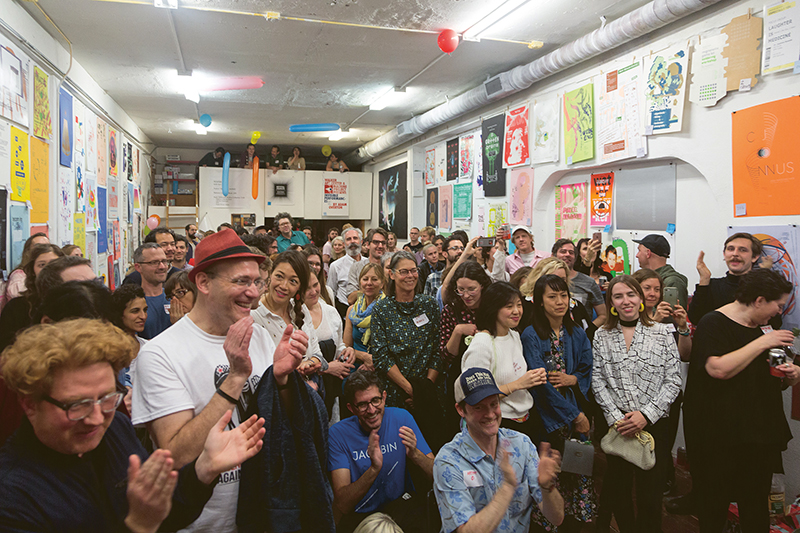
The closing party for Machine Project, Los Angeles, January 13, 2018. Courtesy of Machine Project. Photo: Ian Byers-Gamber.
In Greek mythology, the kings and poets received their power of authoritative speech from the will of the Titan Mnemosyne, whose name shares the root mnḗmē with the English word memory. Mnemosyne also moonlights as the guardian of the pool of remembrance in Hades’s underworld. When you arrive in Hades after death, you can either drink from the river Lethe and forget your past life, or drink from the pool of memory and remember it as your soul passes into its next incarnation. If we drink from the wrong pool, we’ll be banished to remain in a mock-up of the past where nothing regenerates. This is the unvarying space where we go to exalt the facade of where we once were, a lifeless place from which we can never move forward, up, or out. Buildings are where the private things occur, the good and the disturbed; they speak with authority of the things worth remembering.19 They change as we do, for us and by us. If our shared cultural spaces are not designed and conceived as alive and active as Pieter, PAM, and Machine are and were, our stories will never reincarnate. We too will be doomed to the stage set.
Meg Whiteford is the author of The Shapes We Make With Our Bodies (Plays Inverse, 2015), the Curator’s Choice for the 2017 BAM Next Wave Festival Reading Room, and Callbacks (&Now, 2018), recipient of the 2016 Madeleine P. Plonsker Emerging Writers Prize. Her plays have been performed at Pieter, PAM, and Machine Project.
